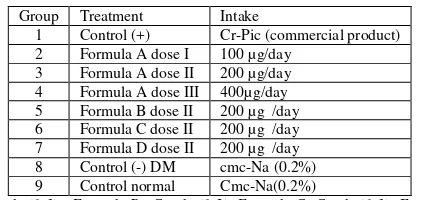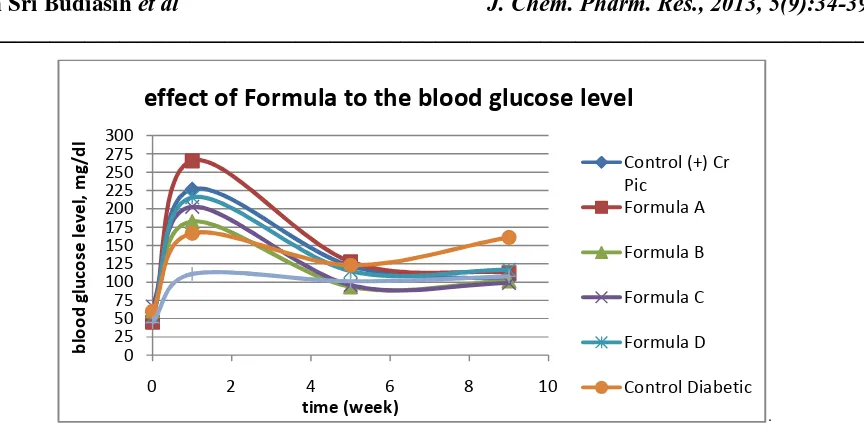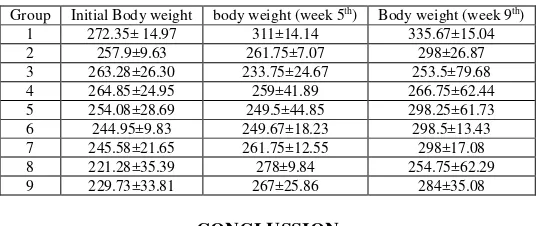Journal of Chemical and Pharmaceutical Research, 2013, 5(9):34-39
Research Article
CODEN(USA) : JCPRC5
ISSN : 0975-7384
Antihyperglicemic activity of some chromium(III)-amino acid complexes in
nicotinamide-streptozotocin induced diabetic wistar rats
Kun Sri Budiasih
1*, Chairil Anwar
2, Sri Juari Santosa
2, Hilda Ismail
3and Ika Puspita Sari
31
Chemistry Education Dept, Faculty of Mathematics and Natural Sciences, Yogyakarta State University, Indonesia
2Chemistry Dept, Faculty of Mathematics and Natural Sciences, Universitas Gadjah Mada, Yogyakarta, Indonesia 3Faculty of Pharmacy, Universitas Gadjah Mada, Yogyakarta, Indonesia
_____________________________________________________________________________________________
ABSTRACT
Investigation of an in vivo application of chromium- amino acid complexes was conducted on nicotinamide-streptozotocin induced diabetic Wistar rats. The rats were divided into 9 groups each consist of 4 animals. Three groups are control (+) with chromium picolinate (CrPic), control (-)diabetic group (DM) and control non diabetic (non DM). Furthermore, three groups wereexamined on the effect of Formula A (Cr-glutamate by 1:3 ratio)at dose (100, 200 and 400 µg/day). In addition, the last 3 groups were studied on the effect of different formula of Cr (III)-glutamato made of Cr-glutamate by ratio 1:2 (200 µg/day), Cr-glycine (1:3) and Cr-cysteine(1:3) complexes. The blood glucose levels were measured before and after treatment. All formulas gave significant effect in lowering glucose level (p 0.05) compared to diabetic rats control group.
Keywords: Antihiperglycemic, amino acid, chromium,complexes, nicotinamide-streptozotocin.
_____________________________________________________________________________________________
INTRODUCTION
Diabetes is a metabolic disease which characterized by hyperglycemia and glycosuria resulting from the defect of the secretion or the action of insulin, or both of them. Prediction of the World Health Organization (WHO) explained that the amount of diabetic patients in Indonesia will increase from 8.4 million at 2000 to 21.3 million in
2030. International Diabetes Federation (IDF) also predicted the similar condition. Prevalence of diabetes mellitus
in Indonesia is 5.7% at 2010 [1,2]. Diabetes currently affects more than 194 million people worldwide and is expected to reach 333 million by 2025,with the maximum burdens falling upon developing countries [3].
Diet, exercise, supplement or nutraceutical, oral hypoglycemic agents and insulin are the particular management of diabetes. Nutraceuticals (often referred to functional foods) are natural bioactive or chemical compounds that have
health promoting, disease preventing or medicinal properties [4].Some natural product were used as antidiabetic or
hypoglycemic agent, for example Raphanus Sativus L. Leaves [5], Allium Cepa, L,[6] andCocos nusifera I [7].
______________________________________________________________________________
Some metal complexes or organo-metallic compounds have been used in medicine for centuries. Metal complexes playessential role in pharmaceutical industry and in agriculture. The metallo-elements present in trace quantities play vital roles at the molecular level in living system. In diabetes, intake of chromium metal complex shown considerable reduction in the glucose level [9].
Supplement contains trivalent Chromium is needed for a person with type2 diabetes mellitus, according to it’simportant role in glucose metabolism. Cr (III) interact with the insulin and its receptors on the first step in the metabolism of glucose entry into the cell, and facilitates the interaction of insulin with its receptor on the cell surface [10][11]. Chromium increases insulin binding to cells, insulin receptor number as well as activates insulin receptor kinase leading to increase sensitivity of insulin receptor. Additional studies are urgently needed to elucidate the mechanism of the action of chromium and its role in the prevention and control of diabetes[12].
The amount of Cr(III) intake is about 200µgCr/ day. The well known chromium supplement is chromium
picolinate, Cr(pic)3. The disadvantage of Cr(pic)3 is the effect of this compound in DNA damage[13]. The damage
presumably through the catalytic formation of reactive oxygen species. As this supplement enters cells intact and it
potentially capable of generating oxidative damage. Administration of the Cr(pic)3 to rats has demonstrated for the
first time that it can give rise to oxidative DNA damage in whole animals[14]. The research for compounds with ability to maintain the blood glucose level or called ‘antihyperglycemic agent’ is still in progress.
Chromium ascorbate complex also proposed for Cr (III) supplement. However, these ascorbate complex also have a potential damage to DNA[15].The next potential compound is the complex of Cr (III) with amino acid.For example,
the Cr(III) complex with D-phenylalanine, Cr(pa)3. Unlike chromium picolinate, Cr(pa)3 does not cleave DNA under
physiological conditions[16].
Ochiai[17] reported that some amino acids with Cr(III) act as a part of GTF (Glucose Tolerance Factor). GTF is a
low molecular weight Chromium (LMWCr), which is, involved in the action of insulin in processing glucose into energy. It is an oligopeptide of molecular weight about 1400, and consists of glycine, cysteine, aspartate and glutamate with the acidic amino acid.This compound binds the molecule of Cr(III) very tightly by ratio 1:4 and involved in the hormonal action of insulin. Natural GTF is a fraction isolated from brewer’s yeast which has a biological activity in glucose metabolism.A solution which contains chromium (III), glycine, glutamic acid and cysteine mimics the biological activity of the naturally occurring GTF [18]Another study reported the relationship between chromium(III) -amino acids complexes with GTF activity using a yeast assay [19].
There is a potential opportunity to develop new Cr(III) - amino acid complexes as antihiperglicemic supplement. In previous study, preparation of Cr-glutamate (Cr-Glu), Cr-glycine (Cr-Gly) and Cr-cysteine (Cr-Cys) was carried out in aqueous solution, varying three variables: reflux duration, pH, and temperature. Ratio of Cr(III): L-glutamic acid which is used in this research are 1:3 and 1:2whereas the ratio of Cr: glycine and Cr: cysteine were 1:3 [20].
The in vivo experiment was studied on Streptozotocin (Stz) – nicotinamide induced diabetic albino rats [21][22]. Collaboration of the two induction agent according to the cytotoxicity of Streptozotocin (Stz) when given alone. Nitcotinamide-Stz induction is a new experimental diabetic model that mimic some features of type 2 diabetes[23].
EXPERIMENTAL SECTION
a.Materials
Cr complexes with amino acid were produced from previous study[20]. All supplement samples were diluted in 0.2% sodium carboxy methyl cellulose (cmc-Na). Nicotinamide (Sigma Aldrich) was diluted in 0.9% NaCl (E-Merck), whereas Streptozotocin / Stz (Sigma Aldrich) was diluted in solution of citrate buffer (pH=4.5).
b.Animals
Wistar rats were bred at Laboratory of Pharmacology, Faculty of Pharmacy, Universitas Gadjah Mada, Yogyakarta, Indonesia. The subjects of the study were 36 male Wistar albino rats ( ±8 weeks old, 200-290 grams). The animals were kept and maintained with standard laboratory condition. Feeding was done with standard laboratory diet and
drinking was allowed with water ad libitum. The amount of animals were determined by Frederer formula,
(n-1)(k-1) ≥ 15, where n is the amount of animals per groups, and k is the amount of groups[24]. In this case, the amount of
c.Induction of diabetes
The induction of diabetes was done by intraperitonial injection of 120mg/kg nicotinamide then followed 15 minutes later by 60 mg/kg streptozotocin[20]. Streptozotocin was dissolved in citrate buffer (pH 4.5) and nicotinamide was dissolved in NaCl 0.9%. Hyperglycemia was confirmed by the elevated blood glucose levels at day 7 after injection.Blood sample was collected from the eye vein. Measurement of blood glucose level was conducted by using spectroscopic methods.
d.Experimental Design
The experimental design was modified from severel previous work [25-30]. The rats were divided into 9 groups consist of 4animals. The supplements administered orally 1ml per day for 9 weeks. Treatment of these groups was described in table 1.
Table 1.Experiment design of supplementation
Group Treatment Intake
1 Control (+) Cr-Pic (commercial product) 2 Formula A dose I 100 µg/day
Note: Formula A : Cr-glu (1:3) ; Formula B : Cr:glu (1:2), Formula C: Cr-gly (1:3); Formula D: Cr-cys (1:3).
e.Data Collection and Analysis
Blood samples were taken and measured at D0 (starting time), D7 (1st week after induction) and D56 (9th week). The
blood was collected from the eye vein.The result were expressed as mean±SD. Comparison between the groups was made by analysis of variance (ANOVA). Overall assessment of in vivo antihyperglycemic activity was stated as % glucose lowering (%GL):
% = × 100% (1)
RESULTS AND DISCUSSION
In this study, the rats were induced to be diabetic. Some induction agent were used to induce diabetic. For example, Alloxan, uric acid, and. Streptozotocin [26]. They work as the detructive agent of beta cells of the Langerhans, so that cause the type 1 deiabetes. Streptozotocin induced diabetes by free radical generation, which causes a massive reduces of insulin secreting beta cells of the islets of langerhans, resulting in decrease in endogenous insulin release.
The antidiabetogenic effect of nicotinamide may be due to an increase in the pool size of NAD++ in beta cells. NAD
++ is the principal metabolite of nicotinamide. The pool size of NAD++ in beta cells in pre diabetic and diabetics is
significanly reduced. Damage and destruction of beta cells may occur via oxidative stress. Increasing of reactive oxigen species in beta cells may result in oxidative damage of DNA, means the DNA strand breaking [27]. Nicotinamide could ameliorate the brain damage induced type 1 diabetic rats. In other words, nicotinamide prevent the occurence of type 1 diabetes. It acts as a cytoprotectant against streptozotocin induced diabetic damage in wistar rats brain. Collaboration of two induction agent in this work give the most similar condition with tipe diabetic subject [28]. Induction of diabetes in the experimental rast were confirmed by the increasing of the blood glucose level after 7 days. All treatment subject showed the glucose level more then 126 mg/dl after induction.
______________________________________________________________________________
.
Fig 1. The effect of formula to the blood glucose level (applied dose: 200 µg/d)
Figure1 showed that after 7 days after induction, all treatment samples surpassed the value to be classified as diabetes with the blood glucose level minimum 126mg/dl. Treatment for 35dayscan lower blood glucose levels in each group to normal level. Further treatment until 9 weeks keep the glucose level in the normal level. The antihypergycmic activity was calculated by equation (1) and the result was listed in table 2. The result og the % GL of Formula A,B,C and D were 57.566, 44.438, 52.327 and 45.817 respectively.
.
Fig.2. Effect of the dose of Formula A to the blood glucose level
0
effect of Formula to the blood glucose level
Table 2. Result of %GL of all formulas
Formula Blood glucose level before treatment (X) (average) Blood glucose level after treatment (Y) (average) (X-Y) %GL A 265.4344 112.6334 152.801 57.566
B 182.5 101.4 81.1 44.438
C 202.7 96.6334 104.0666 52.327
D 215.5667 116.8 98.7667 45.817
The second set of the experiment is the determination of the effect of the dose of Formula A to the blood glucose level. The result of the treatment of Formula A with the variation of dose is shown at figure 2.
Figure 2showedthat the effect of lowering of blood glucose levels occurred in all experimental samples. Treatment with formula A by by 200µg/day yielded the highest decrease of the blood glucose levels to normal level compared to control groups.
Treatment with Cr-Pic (Chromium picolinate) gave some increasing in the body weight. It may cause from
diabetic’s milk (Diabetasol®)as the source of Cr-Pic. Cr-Amino acids did not show a significant difference in the
weight gain (p≥ 0.05). At the beginning of the experiment the weight of all animals are ranging in 221.28 – 272.35
(average) grams. The body weight of the rats were listed at table 3.
Table 3. Body weight data of the animals
Group Initial Body weight body weight (week 5th) Body weight (week 9th)
1 272.35± 14.97 311±14.14 335.67±15.04 2 257.9±9.63 261.75±7.07 298±26.87 3 263.28±26.30 233.75±24.67 253.5±79.68 4 264.85±24.95 259±41.89 266.75±62.44 5 254.08±28.69 249.5±44.85 298.25±61.73 6 244.95±9.83 249.67±18.23 298.5±13.43 7 245.58±21.65 261.75±12.55 298±17.08 8 221.28±35.39 278±9.84 254.75±62.29 9 229.73±33.81 267±25.86 284±35.08
CONCLUSSION
Study in 9 weeks on the treatment groups give significant effect in lowering glucose level (p 0.05) compared to diabetic rats control group. All the Cr-amino acid complexes applied in this research have an antihyperglicemic activity on Nicotinamide-Sreptozotocin induced diabetic Wistar rats.
Acknowledgment
Thank you for The Ministry of Education and Culture, Directorate of Higher Education, for the Support Funding, by
Hibah Disertasi Doktor scheme.
REFERENCES
[1]WHO, Report of a WHO Consultation World Health Organization, Department of Non communicable Disease
Surveillance, 1999, Geneva.
[2]A Pranoto, A Sutjahjo, A Tjokroprawiro, S Murtiwi, S Wibisono, LPPM,2011,Universitas Airlangga, Surabaya.
[3]D Bhowmik, Chiranjib.B, J Yadav, MR Chandira, J. Chem. Pharm.Res. 2009, 1 (1): 38-53
[4]H Dureja, DKaushik, V Kumar, Indian Journal Of Pharmacology, 2003, 35: 363-372
[5]S.P. Macharla, V. Goli, S.R. Sattla, J. Chem. Pharm. Res., 2012, 4(3):1519-1522
[6]K. P. S. Kumar, D. Bhowmik, Chiranjib, Biswajit, and P. Tiwari, J. Chem. Pharm. Res., 2010, 2(1): 283-291
[7]CNT Figueira, RM dos Santos, EA Campesatto,IML Lúcio, EC de Araújo and MLA Bastos, J. Chem. Pharm.
Res., 2013, 5(5):297-302
[8] M. Malone, M Rosette, Bioinorganic Chemistry: A Short Course., John Wiley & Sons, Inc., 2002, ISBN:
0-471-15976-X.
[9]K.Hariprasath, B. Deepthi, I. Sudheer Babu, P. Venkatesh, S. Sharfudeen, V. Soumya, J. Chem. Pharm. Res.,
______________________________________________________________________________
[10]Z Krejpcio,Pol.J, Environ. Studies, 2001, 10 (6) 399-404.
[11]JB Vincent, (ed),The Nutritional Biochemistry of Chromium(III),Elsevier,New York, 2007: 139-151.
[12]RA Anderson.,Diabetes& Metabolism, 2007,vol.26, p. 22-27.
[13]D Boghchi, SJStohs, BW Downs, Toxicology, 2002, No. 180 (1), 5-22.
[14]DD Hepburn,JM Burney, KWoski, JB Vincent,Polyhedron, 2003,22 (3):.455-463 .
[15]AA Nedim, BZ Karan, R Öner., C Ünaleroglu, CÖner, J.of Biochem. Mol. Bio.,2003, 36 (4), 403-408.
[16]XPYang, PKamalakannan, C Allyn. MNAOntkoa, XF Cindy, J Rena., N Sreejayan,FEBS Letters, 2005 :579,
1458–1464.
[17]E.Ochiai,Bioinorganic Chemistry, John Willey & Sons, New York. 2008, p.235.
[18]KSKarthikeyan, P Nagababu, K Sastry,Sivarama, S Satyanarayana, Current Trends in Biotechnology and
Pharmacy, 2010, 4(4),908-916
[19]KS Karthikeyan., World Congress of Biotechnology, 2011,NICC, Hyderabad, India.
[20]K.S. Budiasih, C.Anwar, S.J.Santosa, H.Ismail, World Academy of Science Engineering & Technology (Waset)
Journal, 2013: 78, pp 1095-1909.
[21]EU Etuk, 2010, Agric. Bio. J. of. N. Am., 2010:1 (2), 130-134.
[22]A Shirwaikar, K Rajendran, CD Kumar., R Bodla, J. Of. Etnopharmacology : 2004,91 : 171-175.
[23]KM Fararh, Atijo, Y Shimuzu, T Takawaki, Res.Vet Sci, 2001, 73, 279-282.
[24]PG Astiyandani, PG., AWAngga Permana, PD.Vedayanti, ID Cok. MP Larayanthi, Windasari dan
I.A.IWahyuniari, IPTEKMA, 2010,Vol.2 No.1, 01-04.
[25]M.Sharma, M. Siddique, M.W.., Shamim, A.M., Gyanesh, ., and K.K. Pillai, The Open ConferenceProceedings
Journal, 2011,2, 53-58.
[26]MY.Selcuk,B Aygen, A Dogukan, Z Tuzcu, F Akdemir, J Komorowski, M Atalay, K Sahin, Nut.& Met., 2012,
9:30.
[27]S.Shinde,UA. Shindea, G Sharmab, YJ. Xuc, NS Dhallac, K Ramesh, K Goyala, J. of Trace Element.in
Medicine and Biology, 2004, 18 : 23–32.
[28]S Ramachandran, A Rajasekaran, KTKumar. App J. Of Trop. Med :2011, 624-631.
[29]P Murugan, L Pari, Life Sciences, 2006: 79, 1720-1728.
[30]RYanardag, TB Demirci, B Ulkuseven, S Bolkent, S Tunali, SBolkent, Euro.J.Med.Chem,2009,44:818-826.
[31]PC Are, RR Adidala, G Puchchakayala, Eur. J. Biol.Sci, 2011, 3(4); 126-130.


